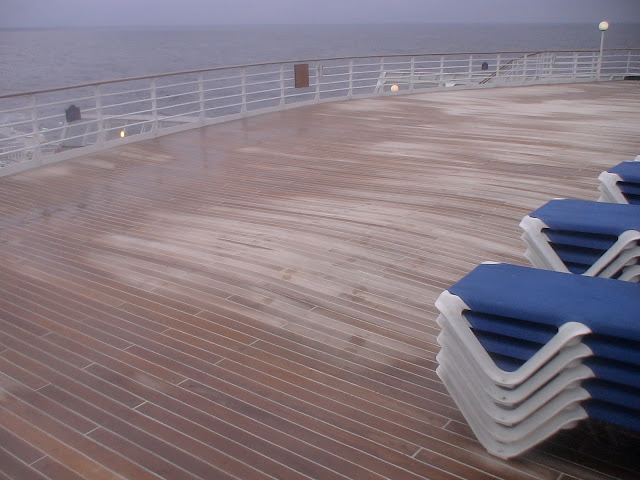It was dark. Passengers were either at the show or eating dinner. No one knew of the "tourist navigation" except a select few crew and those people onshore who were alerted of the event. No one should buy the Captain's flimsy attempt to justify this maneuver after the fact. This was one foolish stunt done by a captain who will pay for the consequences for the remainder of his life. I frankly don't care if Costa knew the captain was going to deviate from course and do this. It really is irrelevant. It was his course and speed that was reckless and irresponsible. He's in command of the ship, whether on bridge or not, and not from Costa management back on land.
Contemplate this; turn ten seconds late and the ship would have ended up on the rocks. Turn ten seconds sooner and Concordia arguably would have escaped this move unscathed and we wouldn't be writing and dwelling on this tragedy. Approaching the island at 15 knots in a ship of that size should never have been contemplated. This course and speed left no room for error and was done for absolutely no reason other than to show off. The ship could easily have stayed a safe distance offshore and still performed this "bow."
The picture above illustrates "tourist navigation" done the right way by Captain Ian McNaught on QE2.
While on board QE2's final lap of honor around the UK back in 2008, a trip which in retrospect, essentially was totally "tourist navigation," Captain McNaught announced the night of October 2nd that the ship would be making an early morning close pass of the port of Douglas on the Isle of Man. This would be a special treat for those on board and onshore; QE2 had never made a port call to the Isle of Man. This would be her first and only, even if it was only a "flyby."
QE2 and Cunard have one strong Isle of Man connection. The Isle of Man is famous for their commemorative stamp issues, many of which feature Cunard ships. There would be a commemorative issue for this occurrence, of which I purchased one on board, signed by the Captain himself. Clearly, while this event wasn't officially listed on the voyage itinerary, it was a completely pre-planned event.
I managed to make it up on deck for the arrival in the early morning. Daybreak was imminent and while the ship had slowed, the wind was bone chilling.
With the decks freshly washed down, the ship still lit up, and the sun on the horizon, the lighting could not have been better.
As we approached Douglas Harbor, the ship slowed to a crawl, but not the wind, which was blowing offshore. This is as close as we were going to get. In this photo, the wide angle lens makes it appear a bit farther, but still, we were a very safe distance offshore.
Off to our starboard, several smaller vessels arrived to take a closer look at us (lights off on the horizon).

The rugged shoreline of the Isle of Man reminded me of the coastline of Scotland. Someday, I must return to the home of Thomas the Tank Engine!
Actually, I really wasn't the only crazy one up here. Those passengers who got up and made it up to forward observation deck were all on the other side. Damn it was cold!
You could actually make out cars lined up along the service road lining the cliffs. I highly doubt Captain McNaught had alerted the island via Facebook we were arriving!
In retrospect, McNaught actually lived up to his nickname on this trip as well! Our first port of call was to be Cherbourg, France on this trip, but this was changed due to high winds. QE2 would never call on that port again. As McNaught would say, his ultimate responsibility is the safety of the ship and passengers. No arguments with me there. Not a shred of doubt ever entered my mind that this was not his highest priority. With the Concordia disaster, that unwavering faith is still very much present in my mind in regards to Cunard and their captains, but has been shaken somewhat with Costa, a line we have cruised on three times in the past. Is their a culture amongst the management and crew of Costa that would allow this to happen? Questions in this line of thinking will need to be addressed in the various investigations and trials that no doubt will follow.
As seen here, as the ship is turning, the stern naturally swung wide, similar to what Concordia would have done with a last minute course correction, which ultimately resulted in the large gash and remaining boulder in her hull as her hull swung around and hit the reef.
Early morning sun on the horizon, a photographers delight for early morning light.
QE2's iconic open bridge wings in the dramatic early morning sun. I could have stayed here longer, but the wind and temperature forced me back indoors.
This was one of the few times I was able to be on the forward observation deck to enjoy the morning sun over the bow. It was still cold, but worth it all.
With the Isle of Man to our stern, we were then off to Liverpool for QE2's final call which would include a memorable concert in the Liverpool Cathedral, and then glorious fireworks display at sailaway.
Now that is how "tourist navigation" is done! Captain McNaught, and all Cunard Captains past and present, thank you all for a safe passage and the peace of mind we were aboard the safest ships in the world commanded by expert captains.

































































